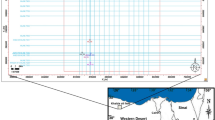Abstract
The construction of a detailed geological model of the object under study is necessary to ensure the successful conduct of seismic exploration and the subsequent development of a hydrocarbon reservoir. This stage is crucial concerning fields in a carbonate environment, widespread in the north of Eastern Siberia, particularly for the Yurubcheno-Tokhomskaya zone. Indeed, such hydrocarbon reservoirs are characterized by an extremely complex internal structure represented by the presence of multiple accumulations of subseismic objects, such as caverns, fractures and fracture corridors. A definition is given in this work, and technology for constructing a digital twin of a geological object is provided. The digital twin of a geological object in our understanding is a set of data that determine its geometric and physical properties in conjunction with the corresponding synthetic geophysical fields. In this work, a seismic digital twin of one of the Yurubcheno-Tokhomskaya zone objects is constructed.
This work describes the technology for constructing a digital twin of one of the most complex geological objects - a cavernous-fractured hydrocarbons reservoir, complicated by geological faults. At this stage, we are interested in this object’s elastic characteristics, which affect its interaction with seismic waves. Three-dimensional seismic data and borehole observations are used as input information. We pay special attention to faults’ construction, given their thin internal structure filled with fractured breccias. To do this, we use discrete element modelling of fault formation, which allows us to take into account the fragmentation of the geological rock. The constructed multi-scale model destination performs full-scale numerical simulation; the main goal is to obtain an accurate description of the scattered waves. We use the previously developed finite-difference methods using grids with local refinement in time and space to describe their occurrence and propagation processes. As a result, we got a digital twin of a specific geological object. By this term, we mean a detailed full-scale elastic model together with the calculated seismic wave field.
Access this chapter
Tax calculation will be finalised at checkout
Purchases are for personal use only
Similar content being viewed by others
References
Babich V.M., Buldyrev V.D.: Asymptotic methods in short-wavelength diffraction theory. Alpha Science International (2009)
Bazaikin, Y., et al.: Effect of CT image size and resolution on the accuracy of rock property estimates. J. Geophys. Res. Solid Earth. 122(5), 3645–3647 (2017)
Botter, C., Cardozo, N., Hardy, S., Lecomte, I., Escalona, F.: From mechanical modeling to seismic imaging of faults: a synthetic workflow to study the impact of faults on seismic. Mar. Petrol. Geol. 57, 187–207 (2014)
Duan, K., Kwok, C.Y., Ma, X.: DEM simulations of sandstone under true triaxial compressive tests. Acta Geotechnica 12(3), 495–510 (2017)
Faulkner, D.R., et al.: A review of recent developments concerning the structure, mechanics and fluid flow properties of fault zones. J. Struct. Geol. 32, 1557–1575 (2010)
Hardy, S., Finch, E.: Discrete-element modelling of detachment folding. Basin Res. 17(4), 507–520 (2005)
Hardy, S., Finch, E.: Mechanical stratigraphy and the transition from trishear to kink-band fault-propagation fold forms above blind basement thrust faults: a discrete-element study. Marine Petrol. Geol. 24, 75–90 (2007)
Kolyukhin, D.R., et al.: Seismic imaging and statistical analysis of fault facies models. Interpretation 5(4), SP71– SP82 (2017)
Kostin, V.I., Lisitsa, V.V., Reshetova, G.V., Tcheverda, V.A.: Local time-space mesh refinement for simulation of elastic wave propagation in multi-scale media. J. Comput. Phys. 281, 669–689 (2015)
Landa, E., Reshetova, G., Tcheverda, V.: Modeling and imaging of multiscale geological media: exploding reflectors revisited. Geosciences 8(12), 486 (2018)
Popov, M.M.: Ray theory and Gaussian beam method for geophysicists. Efuba, Salvador-Bahia (2002)
Protasov, M.I., Reshetova, G.V., Tcheverda, V.A.: Fracture detection by Gaussian beam imaging of seismic data and image spectrum analysis. Geophys. Prospect. 64(1), 68–82 (2016)
Protasov, M.I., Tcheverda, V.A., Pravduhin, A.P.: 3D true-amplitude anisotropic elastic Gaussian beam depth migration of 3D irregular data. J. Seis. Explorat. 28(2), 121–146 (2019)
Questiaux, J.-M., Gary, D., Couples, G.D., Ruby, N.: Fractured reservoirs with fracture corridors. Geophys. Prospect. 58, 279–295 (2010)
Vishnevsky, D.M., et al.: Correlation analysis of statistical facies fault models. Doklady Earth Sci. 473(2), 477–481 (2017)
Acknowledgement
The work is supported by Mathematical Center in Akademgorodok, the agreement with Ministry of Science and High Education of the Russian Federation number 075-15-2019-1613.
Author information
Authors and Affiliations
Corresponding author
Editor information
Editors and Affiliations
Rights and permissions
Copyright information
© 2021 Springer Nature Switzerland AG
About this paper
Cite this paper
Cheverda, V., Lisitsa, V., Protasov, M., Reshetova, G. (2021). Digital Twins of Hydrocarbon Reservoir. In: Gervasi, O., et al. Computational Science and Its Applications – ICCSA 2021. ICCSA 2021. Lecture Notes in Computer Science(), vol 12958. Springer, Cham. https://doi.org/10.1007/978-3-030-87016-4_48
Download citation
DOI: https://doi.org/10.1007/978-3-030-87016-4_48
Published:
Publisher Name: Springer, Cham
Print ISBN: 978-3-030-87015-7
Online ISBN: 978-3-030-87016-4
eBook Packages: Computer ScienceComputer Science (R0)




